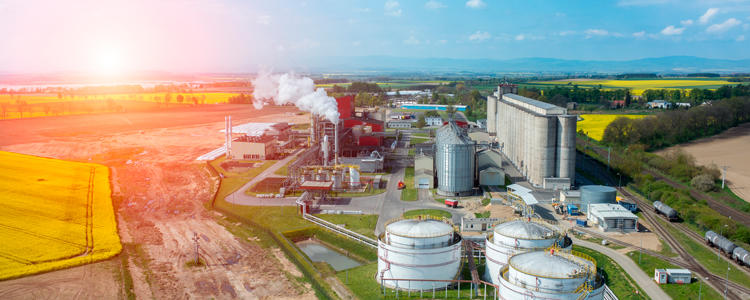We all know that we didn’t pick the path of least resistance by choosing to be in the ethanol industry. This is an industry that is largely driven by two unrelated commodities which cause periods of high and low margins. Currently, we are all seeing lower ethanol margins on sells due to increased ethanol inventories, as well as unrest in U.S. legislation and the export markets.
But remaining idle during this period is not an effective position for ethanol plants.The difference between the winners and losers in periods where there are low ethanol margins is highly dependent on whether there is a plan of action prior to the market worsening.
There are choices we make every day that determine the outcome of each business decision. The worst choice a business can make is to be passive and justify inaction by attributing it to the markets being cyclical.
The difference between being profitable or unprofitable in these times is largely determined by whether you are proactive or reactive. If your response is to be reactive to the markets, it is very hard to increase profits or even minimize losses. A proactive response, on the other hand, will function to utilize your greatest assets, understand cost structure, and allow for diversification – resulting in meaningful advantages for your business.
Ethanol Plants Should Embrace Tight Marginal Periods with ‘Yes MAM’ Mentality
Hailing from a military upbringing, I was taught to address people with either “Yes, Sir” or “Yes, Ma’am” out of respect and polite address. I didn’t always want to get my room in order, or brush my teeth, but when my mother demanded it, I said, “Yes Ma’am.”
This has stuck with me in life, and I often witness a correlation between this and how businesses are run. To get the most out of them, we need to address them with respect and take on a “Yes, Ma’am” mentality. In the case of business, I’ve created the MAM business mentality, which includes: Monitoring, Analyzing/Adapting, and Making Informed Decisions. Each piece of this is equally important, and only truly effective when all three pieces are used in conjunction together. It has been especially successful for ethanol plants running through tight marginal periods.
Monitoring – In Good and Bad Times
The vast majority of ethanol plants do a great job of monitoring operational efficiencies. I guarantee that every plant manager can easily tell you at any given point what the yields are, or what the starch content is on the back end. The only problem with this is that it is all based on the efforts to produce as much ethanol as possible. Furthermore, the information that is monitored is saved, but rarely reviewed after any given month or quarter.
Now, don’t get me wrong, those are good things. I will challenge anyone, however, that these are only great when margins are good. The most meaningful information to be monitored is production information when running efficiencies are less than optimal.
It is imperative to fully understand the tendencies of the plant at a variety of run rates. In addition, there are a number of variables other than the run rates that effect the plant’s efficiencies. The largest variable that I have seen is the starch content of the grains. Each harvest, we know that there will be some variability in the starch content of grain. Plants dial in on the plant to produce the best ethanol achievable. However, the process of understanding how to optimize each time there is a change in the variables is learned each time. To be able to inhibit positive change, we need to look at the “A” in MAM.
Analyze and Adapt – Using Information to Your Advantage

To this point, Monitoring has allowed plants to gather a great amount of data. The only problem is, data is not very useful. For it to be useful, we need to turn the data into information. In my opinion, this is the hardest part of the process and the one that usually receives the least attention.
The “A” in MAM is for Analyze and Adapt. Again, when margins are high and the plant is running smooth, the need to truly analyze the data is less urgent, but analyzing the data upon varying run rates and with changes in other plant variables is vital at all times. Through this analysis, we are able to understand not only what areas of the plant production are static, but also the areas we have the ability to adjust and fine-tune.
The understanding of how efficient production was attained is only half of the battle in this step. The other challenge is a plant’s ability to summarize the data and store it so that in the future it can be repeatable in a short amount of time. This will also allow employees to quickly understand a variety of scenarios and differing challenges, and utilize information on how it was overcome in the past.
I do realize that there are rarely two of the same situations in the plant, and that’s where the second piece of the A comes into play: Adapt. The analysis is merely a roadmap to get plants close to running efficiently. However, past experiences will only get you close and not all the way there. Plants have to be able to adapt quickly to slight changes in the production process to further dial in the efficiencies.
The analysis will greatly reduce the time needed to make course corrections in the plants while that adaptation will allow for the minor changes needed to ensure you are making every possible gallon of ethanol from the feedstock. This ties into the final piece of the “Yes MAM” business model: Making Informed Decisions.
Making Informed Decisions – A Healthy Plant is a Happy Plant
I believe the single, biggest reason why plants tend to be reactive rather than proactive to adverse margin times is because they don’t easily have the necessary information to make the best decision.
Time and time again, when there is an overstock of ethanol inventory and the other plants need to slow production, I hear plants saying they are still going to produce at max capacity. And that may be the right decision, but rarely has the right information been evaluated to ensure that is the right decision.
It seems to me that the only times that the information is completely evaluated is when the situation is dire like it was in 2012. I would argue that the overall health of any ethanol plant is determined on their ability to make informed decisions during the times other than when the environment is either exceptional or dire.
We all know that there is a lot of volatility in the ethanol and grain markets, and no one can predict margins from day to day, but by fully monitoring useful data, analyzing it and adapting where needed, it will allow for plants be able to make informed decisions. When asked if the plant is the most profitable it can be, you can honestly say, “Yes, MAM!”










